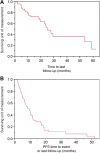Impact of Metastasectomy in the Multimodality Approach for BRAF V600E Metastatic Colorectal Cancer: The Mayo Clinic Experience
- PMID: 28904173
- PMCID: PMC5759813
- DOI: 10.1634/theoncologist.2017-0230
Impact of Metastasectomy in the Multimodality Approach for BRAF V600E Metastatic Colorectal Cancer: The Mayo Clinic Experience
Abstract
Background: BRAF V600E mutations are present in 8%-10% of patients with metastatic colorectal cancer (mCRC) and portend poor prognosis. This study investigated the impact of metastasectomy for patients with BRAF V600E mCRC.
Subjects, materials, and methods: Using prospective clinical and molecular data, patients with BRAF V600E mCRC were analyzed for clinical characteristics and survival. Statistical analyses utilized the Kaplan-Meier method, log-rank test, and Cox proportional hazard models.
Results: Fifty-two patients were identified between July 1, 2008, and January 4, 2016. Patient characteristics included median age 65 years, 61% female, Eastern Cooperative Oncology Group performance status ≤1, 71% with right-sided tumors, and 28% with liver-limited metastasis. In the first-line setting, 7% (4/52) received fluorouracil, leucovorin, oxaliplatin, and irinotecan (FOLFOXIRI)/bevacizumab (BEV) and 81% were treated with doublet chemotherapy consisting of fluoropyrimidine, oxaliplatin, and BEV. Median overall survival (OS) for all 52 patients was 25 months with median progression-free survival (PFS) of 9.3 months. With median follow-up of 18.3 months, 21 patients underwent metastasectomy with longer OS (29.1 months vs. 22.7 months, hazard ratio [HR] = 0.33; confidence interval [CI], 0.12-0.78; p = .01) and PFS (13.6 months vs. 6.2 months, HR = 0.53, CI, 0.28-0.97; p = .03) compared with the non-metastasectomy cohort. In multivariate analysis, metastasectomy remained significant for improved survival outcomes (HR = 0.52; 95% CI, 0.07-1.02; p = .02). Median disease-free survival after metastasectomy was 9.7 months (95% CI, 5.5-19.5). Two patients remain disease-free at the time of last follow-up, with one patient without relapse for greater than 2 years (28.9 months).
Conclusion: Multimodality therapy incorporating metastasectomy for BRAF V600E mCRC should be considered and might be associated with improved overall survival in select patients.
Implications for practice: BRAF V600E metastatic colorectal cancer (mCRC) represents an extremely difficult molecular subset of colorectal cancer to treat. To date, this subset remains refractory to standard chemotherapies, prompting extensive clinical investigation regarding novel treatment approaches and targeted modalities. While the use of metastasectomy for expanded RAS wild-type and RAS mutated mCRC has resulted in improved overall survival for select patients, utilization of metastasectomy in patients with BRAF V600E mCRC remains controversial. This article explores the authors' experience with BRAF V600E mCRC to ascertain whether a multidisciplinary approach incorporating metastasectomy for well-selected patients improves overall survival.
摘要
背景.8%‐10%的转移性结直肠癌(mCRC)患者中存在BRAF V600E突变, 而BRAF V600E突变意味着预后较差。本研究考察了转移瘤切除术对BRAF V600E mCRC患者的影响。
受试者, 材料和方法.使用前瞻性临床和分子数据对BRAF V600E mCRC患者的临床特征和生存率进行了分析。使用Kaplan‐Meier法, 对数秩检验和Cox比例风险模型进行了统计分析。
结果.2008年7月1日至2016年1月4日期间, 共确定了52例BRAF V600E mCRC患者。患者特征包括中位年龄为65岁, 61%为女性, 东部肿瘤协作组体能状态评分≤1, 71%的患者患有右侧肿瘤, 28%仅有肝转移瘤。在一线治疗背景下, 7%(4/52)接受氟尿嘧啶、亚叶酸、奥沙利铂和伊立替康(FOLFOXIRI)/贝伐珠单抗(BEV)治疗, 81%接受包括氟尿嘧啶类、奥沙利铂和BEV在内的双药化疗。所有52例患者的中位总生存期(OS)为25个月, 中位无进展生存期(PFS)为9.3个月。中位随访期为18.3个月。与未行转移瘤切除术的患者队列相比, 21例行转移瘤切除术患者的OS[29.1个月vs.22.7个月, 风险比(HR)= 0.33, 置信区间(CI)为0.12–0.78, p = 0.01]和PFS(13.6个月vs.6.2个月, HR = 0.53, CI为0.28–0.97;p =0.03)更长。在多变量分析中, 转移瘤切除术仍可显著改善生存结局(HR = 0.52;95% CI, 0.07–1.02;p =0.02)。转移瘤切除术后的中位无病生存期为9.7个月(95% CI, 5.5–19.5)。最后一次随访时有2例患者仍然无病生存, 1例患者的无复发时间超过2年(28.9个月)。
结论.对于BRAF V600E mCRC, 应考虑包括转移瘤切除术在内的多学科治疗, 在选定患者中, 多学科治疗可能可以改善总生存期。
对临床实践的启示:BRAF V600E转移性结直肠癌(mCRC)是极其难以治疗的结直肠癌分子亚集。迄今为止, 使用标准化疗治疗该亚集仍然无效, 因此需对新疗法和靶向疗法进行广泛的临床研究。使用转移瘤切除术治疗扩大的RAS野生型和RAS突变型mCRC已被证实可延长选定患者的生存期, 但使用转移瘤切除术治疗BRAF V600E mCRC患者仍存在争议。我们对有关BRAF V600E mCRC的经验进行了回顾, 以确定使用包括转移瘤切除术在内的多学科方法是否可以改善选定患者的总生存期。
Keywords: Metastatic colorectal cancer • BRAF V600E • Metastasectomy • Multimodality therapy.
© AlphaMed Press 2017.
Conflict of interest statement
Disclosures of potential conflicts of interest may be found at the end of this article.
Figures




References
-
- Davies H, Bignell GR, Cox C et al. Mutations of the BRAF gene in human cancer. Nature 2002;417:949–954. - PubMed
-
- Tie J, Gibbs P, Lipton L et al. Optimizing targeted therapeutic development: Analysis of a colorectal cancer patient population with the BRAF(V600E) mutation. Int J Cancer 2011;128:2075–2084. - PubMed
MeSH terms
Substances
LinkOut - more resources
Full Text Sources
Other Literature Sources
Medical
Research Materials

